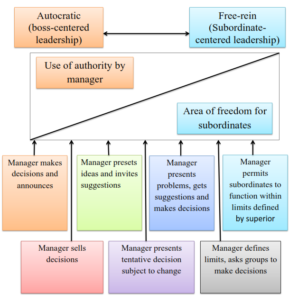2. Leadership as a Continuum
Robert Tannenbaum and Warren H. Schmidt suggested that there are variety of leadership styles moving from a very autocratic style at one end to a very democratic style at the other end.
As the spectrum demonstrates, there are a number of alternative ways in which a leader(manager) can relate himself to the group. At the extreme left of the spectrum, the emphasis is on the leader(manager) –on what he is interests in , how he sees things, how he feels about them . As we move towards the employee-centered end of the spectrum, however, the focus is increasingly on the subordinates – on what they are interested in , how they look at things, how they feel about them. The center of the spectrum finds a more equitable balance between the authority exercised by the leader and the amount of participation the group exercise.
Various points on the spectrum are described below:
i. Manager makes decisions and announces it
In this case, the manager who is frankly authoritarian , tells employees what his decision are, and demands unquestioning obedience. He does not give any importance to what his employees will think about his decisions.
ii. Manager sells his decision
Here the manager behaves like a diplomat. Although like an autocrat he has already taken a decision, he prefers to take the additional step of persuading his subordinates to accept it. He tells them what they will gain from his decision and how his decision will fulfill their needs and aspirations.
iii. The manager having made a decision presents his ideas, invites questions
Here the manager who has arrived at a decision provides an opportunity for his subordinates to get a fuller explanation of his thinking and his intentions. He presents his ideas to the subordinates and invites questions so that his associates can better understand what he is trying to accomplish.
iv. The manager presents tentative decisions, subject to change.
The manager identify and diagnose the problem and arrives at a tentative decision. But before finalizing the decision he presents it to his subordinates to know their reactions.
v. The manager presents the problems, gets suggestions and then makes his decision.
In case the manager presents the problem to the subordinates ans ask for alternate solutions. He then selects the most promising solutions to the problem. In this way he reserves the final decision to himself.
vi. The manager defines the problem and limits of action and lets the group make a decision.
The manager defines the problems to be solved and the boundaries within which the decision must be made. The group has the right to make decision either by consensus or majority vote.
vii. The manager permits the group to make decisions within limits defined by the situation
This represents an extreme degree of group freedom only occasionally encountered in formal organisation.
An important question here is that at which point along the continuum should a manager adopt his behavior? The level depends upon three aspects:
a) Forces in Manager
It involves manager’s value system , his confidence in his subordinates, his own leadership inclinations, and his feeling of security in an uncertain situation.
b) Forces in subordinates
It involves subordinate’s need for independence. Readiness to assume responsibility for decision making, level of tolerance for ambiguity, understanding and identifying organsiaitonal goals, interest in the problem, knowledge and experience to deal with the problems and learing to expect to share in decision making.
c) Forces in the situation
It involves type of organisation, group effectiveness, the problem itself and the pressure of time.

